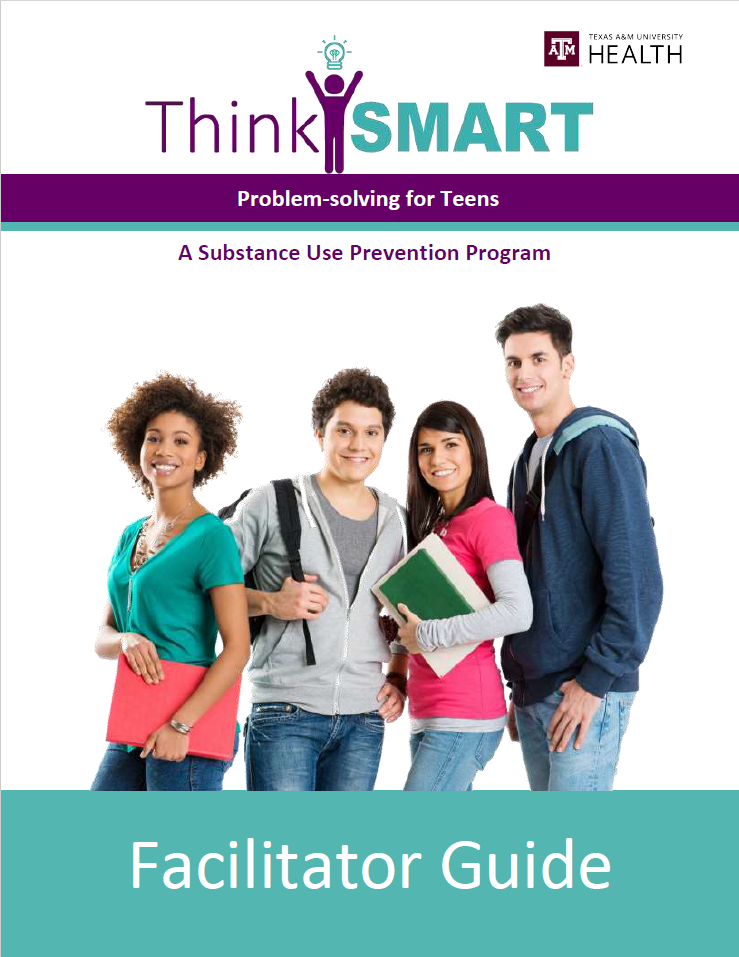Think SMART

At the core of our educational offerings is the Think Smart curriculum, a five-week program designed to build essential life skills such as decision-making, emotional regulation, goal-setting, and refusal strategies. This curriculum emphasizes the dangers of opioid misuse, particularly fentanyl, while also helping students navigate common challenges such as peer pressure, impulsivity, and emotional dysregulation. Crucially, Think Smart aligns with Texas legislation, including compliance with the Texas Essential Knowledge and Skills (TEKS) and Texas House Bill 3908 (Tucker’s Law) that mandate 10 hours of opioid prevention education, by blending legal requirements with practical, engaging lessons.
To further reinforce the lessons from Think Smart, the TOPS initiative incorporates several companion products tailored to different age groups, including Split Second and Trust Hustle.
Split Second
A graphic novel designed for middle and high school students, Split Second presents the complexities of opioid misuse, peer pressure, and recovery through an engaging narrative. The novel is divided into three chapters, each focusing on a different stage of drug exposure and recovery. It vividly portrays the choices students may face regarding drug use, the devastating consequences of overdose, and the long and challenging path to recovery. By highlighting the recovery process and focusing on empathy, Split Second reduces the stigma associated with addiction and encourages students to seek help. It also teaches refusal skills, empowering students to make informed decisions about substance use.

Trust Hustle

An interactive mobile game, Trust Hustle is another powerful tool designed for middle and high school students. Through simulated social situations and real-world scenarios, students practice refusal skills and make strategic decisions when confronted with peer pressure and drug involvement. The game rewards critical thinking and teaches students how to recognize manipulation tactics often used by drug dealers. By navigating risk-laden environments safely, students reinforce the behavioral changes introduced in Think Smart and Split Second. Trust Hustle provides an immersive learning experience that engages students while reinforcing the importance of making safe decisions.
Beyond opioid prevention, the TAMU OTF also addresses broader risk factors that contribute to substance misuse. Students build resilience by developing the skills necessary to cope with challenges such as emotional dysregulation, trauma exposure, and family or community substance use. The program provides strategies to help students manage their emotions, recognize potential triggers, and navigate environments where drug use may be present. These lessons empower students to make positive choices, even in the face of external pressures.
We recommend the following upstream prevention initiatives and have established partnerships for referral and delivery for the types of critical mental health services listed below.
Upstream Prevention Initiatives
School Counseling & Peer Counseling
We recommend integration of Screening, Brief Intervention, and Referral to Treatment (SBIRT) into school settings, providing an evidence-based method for identifying at-risk students and addressing their needs early. SBIRT allows trained school personnel and peer counselors to screen students for risk factors such as emotional dysregulation, trauma exposure, or early signs of substance misuse. Students identified with moderate risk will receive a brief intervention, a structured conversation designed to raise awareness about substance misuse, provide personalized feedback, and discuss strategies for healthier decision-making. Students identified as high-risk, particularly those dealing with severe emotional distress, trauma, or early signs of addiction, will be referred to specialized services. Using the TCHATT (Texas Child Health Access Through Telemedicine) telehealth platform, these students will have access to teletherapy, telepsychiatry, risk assessments, and crisis intervention, ensuring they receive timely and appropriate mental health care.


In addition to professional counseling, the TAMU OTF recommends peer-led support groups for high school students through the Peer Assistance and Leadership® (PAL) Program. Peer counselors trained in opioid awareness and harm reduction principles will provide mentorship and guidance to their classmates. This peer-led approach not only fosters a sense of community and support within the student body but also empowers students to act as advocates and first responders among their peers. PAL participants will be trained in resiliency strategies and refusal skills, allowing them to assist younger students in navigating challenges like peer pressure, substance use, and academic difficulties. The PAL program has a proven track record of reducing substance use, truancy, and disciplinary referrals while improving academic performance and self-confidence.
Family Therapy
Recognizing that family substance use and community drug environments are significant risk factors, the TOPS program proposes to integrate family therapy as part of its upstream intervention strategy. Families in need of therapy services will be identified through the SBIRT process, with school personnel trained to assess not only individual students but also family dynamics during screening sessions. Risk factors such as parental substance use, intergenerational addiction, and exposure to trauma or unstable home environments will help identify families in need of further support. Family therapy will utilize evidence-based techniques, including Cognitive Behavioral Therapy (CBT), Structural Family Therapy, and Multidimensional Family Therapy (MDFT). These approaches aim to address negative family patterns, improve communication, and enhance problem-solving skills within the family unit. The primary goals of family therapy, especially for those with high-risk factors, are to reduce the impact of family substance use, improve communication and emotional expression, and enhance family functioning. Families will be taught how to manage trauma and stress, creating a safer and more nurturing home environment. Through referrals to Federally Qualified Health Centers (FQHCs), local MHMR authorities, or other community-based providers, families will receive tailored, evidence-based interventions that promote long-term recovery and well-being for both students and caregivers.

Telebehavioral Health Services (TCHATT) and TAMU Telebehavioral Health

Telehealth psychological services have proven effective in reducing barriers to care, particularly for students in rural or underserved areas. By delivering mental health services directly to schools, TCHATT ensures that students receive the care they need before their emotional and behavioral health challenges lead to more serious issues like substance misuse.
The TCHATT (Texas Child Health Access Through Telemedicine) platform will provide telehealth services to students identified through the SBIRT process or by school personnel. TCHATT offers a range of services that address the unique needs of children and adolescents, including teletherapy, telepsychiatry, and crisis intervention. For students dealing with emotional dysregulation, trauma, or mental health crises, TCHATT provides brief interventions, typically lasting 2-4 sessions, to stabilize the student’s mental health and prevent further escalation into substance use. For students requiring extended care, TCHATT will refer them to long-term counseling services through community-based practitioners. Texas A&M Telebehavioral Health Care Clinic a member of TCHATT offers a variety of services, including child/adolescent therapy, evidence-based coordinated care, and mindfulness groups.
Healthcare and Mental Health Services
TAMU OFT will collaborate with school nurses and counselors to implement school-wide screening programs aimed at identifying students with opioid use risk factors. These screenings will be followed by mental health evaluations conducted through the TCHATT platform. Students exhibiting higher levels of distress or early signs of substance misuse will receive psychiatric care, brief interventions, and community referrals as needed. To ensure the success of these efforts, ongoing training will be provided to school staff, equipping them to recognize the signs of trauma, emotional distress, and substance use in students and respond appropriately.

Harm Reduction and Long-Term Support

Our prevention programming will go beyond abstinence-only messaging by incorporating harm reduction strategies into the curriculum. These strategies are essential for helping students understand how to minimize the risks associated with drug use and encouraging them to seek help early. Students will learn how to cope with cravings, manage emotional triggers, and develop healthy coping mechanisms that promote long-term recovery and mental wellness. The focus on harm reduction ensures that students are equipped with the knowledge and skills needed to make safer choices in the face of potential substance use and addiction.






